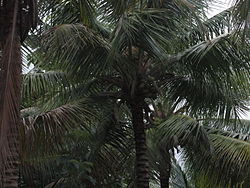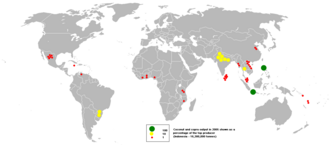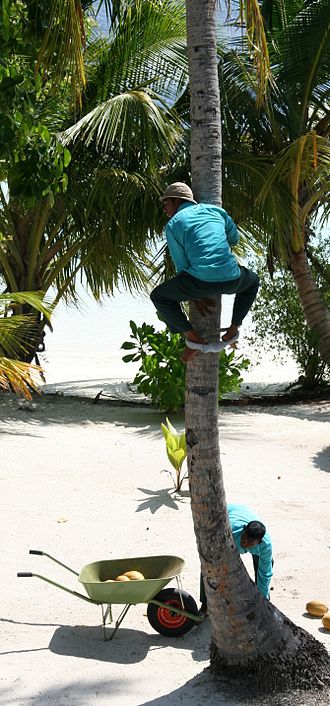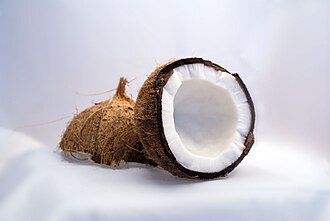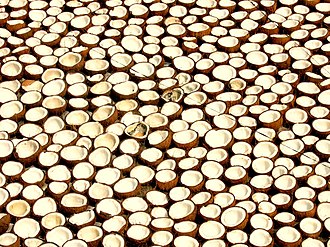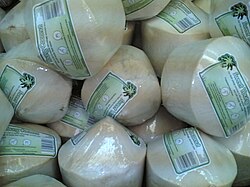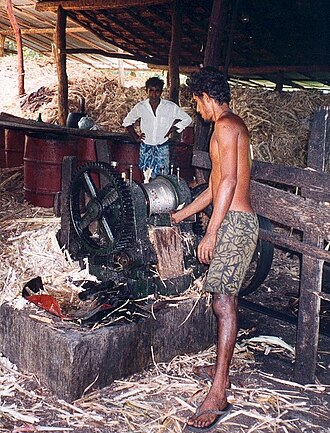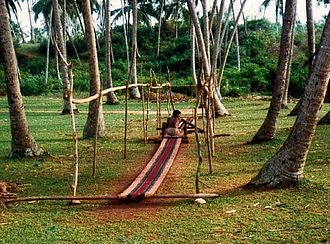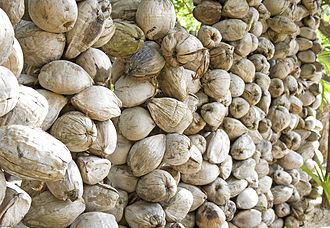AY Honors/Palm Trees/Answer Key
Template:Otheruses Template:Taxobox
The Coconut Palm (Cocos nucifera) is a member of the Family Arecaceae (palm family). It is the only species in the genus Cocos, and is a large palm, growing to 30 m tall, with pinnate leaves 4-6 m long, pinnae 60-90 cm long; old leaves break away cleanly leaving the trunk smooth. The term coconut refers to the fruit of the coconut palm. An alternate spelling is cocoanut.
The coconut palm is grown throughout the tropical world, for decoration as well as for its many culinary and non-culinary uses; virtually every part of the coconut palm has some human uses.
Origins and cultivation
The origins of this plant are the subject of controversy, with most authorities claiming it is native to South Asia (particularly the Ganges Delta), while others claim its origin is in northwestern South America. Fossil records from New Zealand indicate that small, coconut-like plants grew there as long as 15 million years ago. Even older fossils have been uncovered in Rajasthan, Tamil Nadu, Kerala (kera="coconut palm tree" and alam="land" or "location"), Maharashtra, (India) and the oldest known so far in Khulna, Bangladesh. Regardless of its origin, the coconut has spread across much of the tropics, probably aided in many cases by sea-faring peoples. The fruit is light and buoyant and presumably spread significant distances by marine currents. Fruits collected from the sea as far north as Norway have been found to be viable (and subsequently germinated under the right conditions). In the Hawaiian Islands, the coconut is regarded as a Polynesian introduction, first brought to the islands by early Polynesian voyagers from their homelands in the South Pacific. They are now ubiquitous to most of the planet between 26ºN and 26ºS. The coconut palm thrives on sandy soils and is highly tolerant of salinity. It prefers areas with abundant sunlight and regular rainfall (1,500 to 2,500 mm annually), which makes colonizing shorelines of the tropics relatively straightforward.& Coconuts also need high humidity (70–80%+) for optimum growth, which is why they are rarely seen in areas with low humidity, like the Mediterranean, even where temperatures are high enough (regularly above 24°C). They are very hard to establish in dry climates and cannot grow there without frequent irrigation; in drought conditions, the new leaves do not open well, and older leaves may become desiccated; fruit also tends to be shed.& They may grow but not fruit properly in areas where there is not sufficient warmth, like Bermuda.
Coconut palms require warm conditions for successful growth, and are intolerant of cold weather. Optimum growth is with a mean annual temperature of 27°C(80.6°F), and growth is reduced below 21°C(69.8°F). Some seasonal variation is tolerated, with good growth where mean summer temperatures are between 28–37 °C (82.4-98.6 °F), and survival as long as winter temperatures are above 4–12 °C (39.2-53.6 °F); they will survive brief drops to 0 °C(32°F). Severe frost is usually fatal, although they have been known to recover from temperatures of -4 °C(24.8°F).&
The flowers of the coconut palm are polygamomonoecious, with both male and female flowers in the same inflorescence. Flowering occurs continuously, with female flowers producing seeds. Coconut palms are believed to be largely cross-pollinated, although some dwarf varieties are self-pollinating.
Pests and diseases
Coconuts are susceptible to the phytoplasma disease lethal yellowing. One recently selected cultivar, 'Maypan', has been bred for resistance to this disease. The fruit may also be damaged by eriophyid mites. The coconut is also used as a food plant by the larvae of many Lepidoptera (butterfly and moth) species, including the following Batrachedra spp: B. arenosella, B. atriloqua (feeds exclusively on Cocos nucifera), B. mathesoni (feeds exclusively on Cocos nucifera), and B. nuciferae.
Brontispa longissima (the "Coconut leaf beetle") feeds on young leaves and damages seedlings and mature coconut palms. On September 27, 2007, Philippines' Metro Manila and 26 provinces were quarantined due to having been infested with this pest (to save the $800-million Philippine coconut industry).&
Growing in the United States
The only two states in the U.S. where coconut palms can be grown and reproduced outdoors without irrigation are Hawaii and Florida. Coconut palms will grow from Bradenton southwards on Florida's west coast and Melbourne southwards on Florida's east coast. The occasional coconut palm is seen north of these areas in favoured microclimates in the Tampa-St. Petersburg-Clearwater metro area and around Cape Canaveral. They may likewise be grown in favoured microclimates in the Rio Grande Valley area of Deep South Texas near Brownsville and on Galveston Island. They may reach fruiting maturity, but are damaged or killed by the occasional winter freezes in these areas. While coconut palms flourish in south Florida, unusually bitter cold snaps can kill or injure coconut palms there as well. Only the Florida Keys and the coastlines provide safe havens from the cold as far as growing coconut palms on the U.S. mainland.
The farthest north in the United States a coconut palm has been known to grow outdoors is in Newport Beach, California along the Pacific Coast Highway. In order for coconut palms to survive in Southern California they need sandy soil and minimal water in the winter to prevent root rot, and would benefit from root heating coils.
Coconut production in the Middle East
The main coconut producing area in the Middle East is the Dhofar region of Oman. Particular the area around Salalah maintains large coconut plantations similar to those found across the Arabian Sea.The large coconut grooves of Dhofar are already mentioned by the medieval Moroccan traveller Ibn Battuta in his writings known as Al Rihla &.This is possible due to an annual rainy season known locally as Khareef.Coconut are also increasingly grown for decorative purposes along the coasts of UAE and Saudi Arabia with the help of irrigation. The UAE has however imposed strict laws on mature coconut tree imports from other countries to reduce the spreading of pests that can spread to other native palm trees such as the date palm &.
Production
Indonesia is the world leader in coconut production followed closely by the exponentially increasing product of the Philippines. Then, in a distant third India.
| Top Ten Coconut Producers — 2005 | ||||
|---|---|---|---|---|
| Country | Production (Int $1000) | Footnote | Production (MT) | Footnote |
| Template:IDN | 1,474,172 | C | 16,300,000 | F |
| Template:PHL | 1,311,380 | C | 14,500,000 | F |
| Template:IND | 859,180 | C | 9,500,000 | F |
| Template:BRA | 274,380 | C | 3,033,830 | |
| Template:LKA | 176,358 | C | 1,950,000 | F |
| Template:THA | 135,660 | C | 1,500,000 | F |
| Template:MEX | 86,732 | C | 959,000 | F |
| Template:VNM | 85,014 | C | 940,000 | F |
| Template:MYS | 64,212 | C | 710,000 | F |
| Template:PNG | 58,786 | C | 650,000 | F |
| No symbol = official figure, F = FAO estimate, * = Unofficial figure, C = Calculated figure; Production in Int $1000 have been calculated based on 1999-2001 international prices | ||||
The fruit
Botanically, a coconut is a simple dry nut known as a fibrous drupe. The husk, or mesocarp, is composed of fibres called coir and there is an inner stone, or endocarp. The endocarp is the hardest part. This hard endocarp, the outside of the coconut as sold in the shops of non-tropical countries, has three germination pores that are clearly visible on the outside surface once the husk is removed. It is through one of these that the radicle emerges when the embryo germinates. Adhering to the inside wall of the endocarp is the testa, with a thick albuminous endosperm (the coconut "meat"), the white and fleshy edible part of the seed.
Although coconut meat contains less fat than other dry nuts such as peanuts and almonds, it is noted for its high amount of saturated fat.& Approximately 90% of the fat found in coconut meat is saturated, a proportion exceeding that of foods such as lard, butter, and tallow. However, there has been some debate as to whether or not the saturated fat in coconuts is healthier than the saturated fat found in other foods (see coconut oil for more information). Coconut meat also contains less sugar and more protein than popular fruits such as bananas, apples and oranges, and it is relatively high in minerals such as iron, phosphorus and zinc.
The endosperm surrounds a hollow interior space, filled with air and often a liquid referred to as coconut water, not to be confused with coconut milk. Coconut milk, called "santan" in Malay, is made by grating the endosperm and mixing it with (warm) water. The resulting thick, white liquid is used in much Asian cooking, for example, in curries. Coconut water from the unripe coconut, however, can be drunk fresh. Young coconuts used for coconut water are called tender coconuts. The water of a tender coconut is liquid endosperm. It is sweet (mild) with aerated feel when cut fresh. Depending on the size a tender coconut could contain the liquid in the range of 300 to 1,000 ml. It is known in Tamil/Malayalam/Kannada as "elaneer".
When viewed on end, the endocarp and germination pores give the fruit the appearance of a coco (also Côca), a Portuguese word for a scary witch from Portuguese folklore, that used to be represented as a carved vegetable lantern, hence the name of the fruit.& The specific name nucifera is Latin for nut-bearing.
When the coconut is still green, the endosperm inside is thin and tender, often eaten as a snack. But the main reason to pick the fruit at this stage is to drink its water; a big coconut contains up to one liter.
The meat in a young coconut is softer and more like gelatin than a mature coconut, so much so, that it is sometimes known as coconut jelly. When the coconut has ripened and the outer husk has turned brown, a few months later, it will fall from the palm of its own accord. At that time the endosperm has thickened and hardened, while the coconut water has become somewhat bitter.
When the coconut fruit is still green the husk is very hard, but green coconuts only fall if they have been attacked by moulds, etc. By the time the coconut naturally falls, the husk has become brown, the coir has become drier and softer, and the coconut is less likely to cause damage when it drops. Still, there have been instances of coconuts falling from palms and injuring people, and claims of some fatalities. This was the subject of a paper published in 1984 that won the Ig Nobel Prize in 2001. Falling coconut deaths are often used as a comparison to shark attacks; the claim is often made that a person is more likely to be killed by a falling coconut than by a shark, yet, there is no evidence of people ever being killed in this manner.& However, William Wyatt Gill, an early LMS missionary on Mangaia recorded a story in which Kaiara, the concubine of King Tetui, was killed by a falling green nut. Template:Fact The offending palm was immediately cut down. This was around 1777, the time of Captain Cook's visit.
In some parts of the world, trained pig-tailed macaques are used to harvest coconuts. Training schools for pig-tailed macaques still exist both in southern Thailand and in the Malaysian state of Kelantan.& Competitions are held each year to find the fastest harvester.
The shell
| Coconut shell compound
(dry basis) | ||||
|---|---|---|---|---|
| Compound | Percent | |||
| Cellulose | 33.61 | |||
| Lignin | 36.51 | |||
| Pentosans | 29.27 | |||
| Ash | 0.61 | |||
| Source: Jasper Guy Woodroof (1979). "Coconuts: Production, Processing, Products". 2nd ed. AVI Publishing Co. Inc. | ||||
| Coconut shell ash compound | ||||
|---|---|---|---|---|
| Compound | Percent | |||
| K2O | 45.01 | |||
| Na2O | 15.42 | |||
| CaO | 6.26 | |||
| MgO | 1.32 | |||
| Fe2O3 + Al2O3 | 1.39 | |||
| P2O5 | 4.64 | |||
| SO3 | 5.75 | |||
| SiO2 | 4.64 | |||
| Source: Jasper Guy Woodroof (1979). "Coconuts: Production, Processing, Products". 2nd ed. AVI Publishing Co. Inc. | ||||
The roots
The palm has no tap root nor does it have root hairs. Instead, the palm has a fibrous root system &.
The inflorescence
On the same inflorescence, the palm produces both the female and male flowers; thus the palm is monoecious&.
Uses
Nearly all parts of the coconut palm are useful, and the palms have a comparatively high yield, up to 75 fruits per year; it therefore has significant economic value. The name for the coconut palm in Sanskrit is kalpa vriksha, which translates as "the tree which provides all the necessities of life". In Malay, the coconut is known as pokok seribu guna, "the tree of a thousand uses". In the Philippines, the coconut is commonly given the title "Tree of Life".& It its theorised that if you were to become stranded on a desert island populated by palm trees, you could survive purely on the tree and coconut alone, as the coconut provides all of the required natural properties for survival.Template:Fact
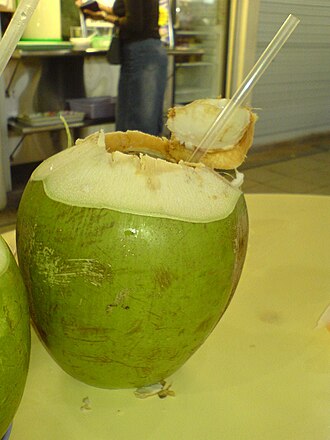
Uses of the various parts of the palm include:
Culinary
- The white, fleshy part of the seed is edible and used fresh or dried in cooking.
- Sport fruits are also harvested, primarily in the Philippines, where they are known as macapuno. They are sold in jars as "gelatinous mutant coconut" cut into balls or strands.
- The cavity is filled with coconut water which contains sugar, fibre, proteins, antioxidants, vitamins and minerals. Coconut water provides an isotonic electrolyte balance, and is a highly nutritious food source. It is used as a refreshing drink throughout the humid tropics and is also used in isotonic sports drinks. It can also be used to make the gelatinous dessert nata de coco. Mature fruits have significantly less liquid than young immature coconuts; barring spoilage, coconut water is sterile until opened.
- Coconut milk is made by processing grated coconut with hot water or milk, which extracts the oil and aromatic compounds. It should not be confused with the coconut water discussed above, and has a fat content of approximately 17%. When refrigerated and left to set, coconut cream will rise to the top and separate out the milk. The milk is used to produce virgin coconut oil by controlled heating and removing the oil fraction. Virgin coconut oil is found superior to the oil extracted from copra for cosmetic purposes.
- The leftover fibre from coconut milk production is used as livestock feed.
- The smell of coconuts comes from the 6-pentyloxan-2-one molecule, known as delta-decalactone in the food and fragrance industry.&
- The sap derived from incising the flower clusters of the coconut is drunk as neera, or fermented to produce palm wine, also known as "toddy" or, in the Philippines, tuba. The sap can also be reduced by boiling to create a sweet syrup or candy.
- Apical buds of adult plants are edible and are known as "palm-cabbage" or heart-of-palm. It is considered a rare delicacy, as the act of harvesting the bud kills the palm. Hearts of palm are eaten in salads, sometimes called "millionaire's salad".
- Ruku Raa is an extract from the young bud, a very rare type of nectar collected and used as morning break drink in the islands of Maldives reputed for its energetic power keeping the "raamen" (nectar collector) healthy and fit even over 80 and 90 years old. And by-products are sweet honey-like syrup and creamy sugar for desserts.
- Newly germinated coconuts contain an edible fluff of marshmallow-like consistency called coconut sprout, produced as the endosperm nourishes the developing embryo.
- In the Philippines, rice is wrapped in coco leaves for cooking and subsequent storage - these packets are called puso.
Non-culinary
- Coconut water can be used as an intravenous fluid.&
- Coir (the fibre from the husk of the coconut) is used in ropes, mats, brushes, caulking boats and as stuffing fibre; it is also used extensively in horticulture for making potting compost.
- Coconut oil can be rapidly processed and extracted as a fully organic product from fresh coconut flesh&, and used in many ways including as a medicine and in cosmetics, or as a direct replacement for diesel fuel.
- Copra is the dried meat of the seed and, after further processing, is a source of low grade coconut oil.
- The leaves provide materials for baskets and roofing thatch.
- Palmwood comes from the trunk and is increasingly being used as an ecologically-sound substitute for endangered hardwoods. It has several applications, particularly in furniture and specialized construction (notably in Manila's Coconut Palace).
- Hawaiians hollowed the trunk to form drums, containers, or even small canoes.
- The husk and shells can be used for fuel and are a good source of charcoal.
- Dried half coconut shells with husks are used to buff floors. In the Philippines, it is known as "bunot", and in Jamaica it is simply called "coconut brush"
- In the Philippines, dried half shells are used as a music instrument in a folk dance called maglalatik, a traditional dance about the conflicts for coconut meat within the Spanish era
- Shirt buttons can be carved out of dried coconut shell. Coconut buttons are often used for Hawaiian Aloha shirts.
- The stiff leaflet midribs can be used to make cooking skewers, kindling arrows, or are bound into bundles, brooms and brushes.
- The roots are used as a dye, a mouthwash, and a medicine for dysentery. A frayed-out piece of root can also be used as a toothbrush.
- Half coconut shells are used in theatre Foley sound effects work, banged together to create the sound effect of a horse's hoofbeats. They were used in this way in the Monty Python film Monty Python and the Holy Grail.
- The leaves can be woven to create effective roofing materials, or reed mats.
- Half coconut shells may be deployed as an improvised bra, especially for comedic effect or theatrical purposes. They were used in this way in the 1970s UK sitcom It Ain't Half Hot Mum for example.
- Drained coconuts can be filled with gunpowder and used as Improvised explosive devices.
- In fairgrounds, a "coconut shy" is a popular target practice game, and coconuts are commonly given as prizes.
- A coconut can be hollowed out and used as a home for a rodent or small bird. Halved, drained coconuts can also be hung up as bird feeders, and after the flesh has gone, can be filled with fat in winter to attract tits.
- Fresh inner coconut husk can be rubbed on the lens of snorkelling goggles to prevent fogging during use.
- Dried coconut leaves can be burned to ash, which can be harvested for lime.
- Coconuts can be used as ammunition for homemade catapults.
- Dried half coconut shells are used as the bodies of musical instruments, including the Chinese yehu and banhu, and the Vietnamese đàn gáo.
- Coconut is also commonly used as a herbal remedy in Pakistan to treat bites from rats.
- The "branches" (leaf petioles) are strong and flexible enough to make a switch. The use of coconut branches in corporal punishment was revived in the Gilbertese community on Choiseul in the Solomon Islands in 2005.&
- In World War II, coastwatcher scout Biuki Gasa was the first of two from the Solomon Islands to reach the shipwrecked, wounded, and exhausted crew of Motor Torpedo Boat PT-109 commanded by future U.S. president John F. Kennedy. Gasa suggested, for lack of paper, delivering by dugout canoe a message inscribed on a husked coconut shell. This coconut was later kept on the president's desk, and is now in the John F. Kennedy Library.
- Coconut trunks are used for building small bridges, preferred for their straightness, strength and salt resistance
See also
- Coconut charcoal
- Coconut cream
- Coconut milk
- Coconut oil
- Coconut water
- Maypan coconut palm
- Coconut candy
References
- ↑ 1.0 1.1 1.2 Species Profiles for Pacific Island Agroforestry: Cocos nucifera (pdf file)
- ↑ Inquirer.net, Beetles infest coconuts in Manila, 26 provinces
- ↑ Medieval Sourcebook: Ibn Battuta: Travels in Asia and Africa 1325-1354
- ↑ http://www.pubhort.org/datepalm/datepalm2/datepalm2_38.pdf
- ↑ Nutrition Facts and Information for Vegetable oil, coconut
- ↑ Figueiredo, Cândido. Pequeno Dicionário da Lingua Portuguesa. Livraria Bertrand. Lisboa 1940. (in Portuguese)
- ↑ Are 150 people killed each year by falling coconuts? The Straight Dope, 19 July 2002. Retrieved 19 October 2006.
- ↑ Training without Reward: Traditional Training of Pig-Tailed Macaques as Coconut Harvesters, Mireille Bertrand, Science 27 January 1967: Vol. 155. no. 3761, pp. 484 - 486
- ↑ 9.0 9.1 P.K. Thampan. 1981. Handbook on Coconut Palm. Oxford & IBH Publishing Co.
- ↑ Fife, Bruce (2005). Coconut Cures. Piccadilly Books, Ltd.. pp. 17. Template:Hide in printTemplate:Only in print. http://books.google.com/books?id=JW8RtCJqZ8MC. Retrieved 2008-04-04.
- ↑ Data sheet about delta-decalactone and its properties: http://www.thegoodscentscompany.com/data/rw1013411.html
- ↑ Template:Cite journal
- ↑ Direct Micro Expelling of Extra Virgin Coconut Oil, Kokonut Pacific Pty Ltd, accessed 4 January 2008
- ↑ Corporal punishment on the Solomon Islands
External links
- Coconut Varieties Endemic to Sri Lanka
- Coconut Time Line
- Plant Cultures: botany, history and uses of the coconut
- Purdue University crop pages: Cocos nucifera
- Coconut
- P. Batugal, V. R. Rao and J. Oliver (2005). Coconut Genetic Resources. COGENT (International Coconut Genetic Resources Network) - IPGRI (International Plant Genetic Resources Institute). http://www.bioversityinternational.org/Publications/pubfile.asp?ID_PUB=1112.
- Descriptors for Coconut (Cocos nucifera L.)
- Coconut Research Center
gn:Mbokaja'a zh-min-nan:Iâ-á bi:Kokonas bg:Кокосова палма ca:Cocoter cs:Kokosovník ořechoplodý da:Kokos de:Kokospalme et:Kookospalm es:Cocos nucifera eo:Kokoso fa:نارگیل fr:Cocotier gl:Coco ko:코코넛 hi:नारियल hsb:Kokosowa palma hr:Kokosova palma id:Kelapa it:Cocos nucifera he:קוקוס jv:Krambil sw:Mnazi (mti) lt:Riešutinė kokospalmė ln:Kokotí ml:തെങ്ങ് mr:शहाळे ms:Pokok Kelapa nl:Kokospalm ja:ココナッツ no:Kokosnøtt pl:Kokos właściwy pt:Coqueiro ro:Cocotier qu:Pikwayu ru:Кокосовая пальма simple:Coconut palm sl:Kokos sr:Кокосова палма su:Kalapa fi:Kookospalmu sv:Kokospalm ta:தேங்காய் te:కొబ్బరి th:มะพร้าว vi:Dừa to:Niu tr:Hindistan cevizi uk:Кокосова пальма yi:קאקאס zh-yue:椰子 zh:椰子

